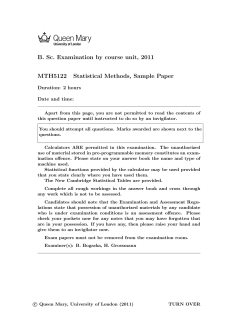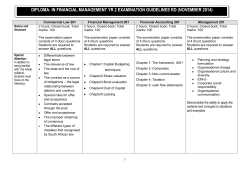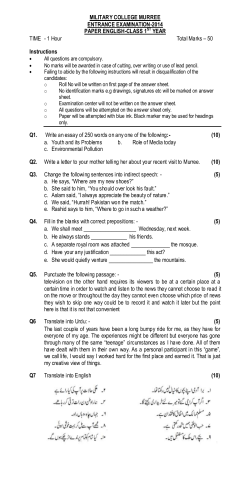
Exam Assignment. - Bioinformatics Institute of India
BIOINFORMATICS INSTITUTE OF INDIA Bioinformatics Institute of India H109, Ground Floor, Sector63, Noida201307, UP. INDIA Tel.: 01204320801 / 02, M. 09818473366, 09810535368 Email: [email protected], Website: www.bii.in Introductory Program in Bioinformatics ....... ....... ........ Examination Assignments April, 2015 BIOINFORMATICS INSTITUTE OF INDIA Instructions for Examination Assignments – April, 2015 · Electronic (email, fax) submission of the assignments is not acceptable. · The assignments have to be submitted by the student on standard A4 size paper in eligible hand written, typed or printed format only. · Do not copy from the answers of other participants. If it is noticed the assignment of such participants will not be accepted. · The assignment for each paper should be written separately. Do not write the assignment for all the papers in continuity. However, all the assignments are to ....... ........ ....... be submitted together. · No two or more participants should submit their assignments in same envelope. · The participants should mention their Name and Enrollment Number on each page of submitted assignment copy. · The last date of submission of Assignments is 30th April, 2015. · The assignments have to be submitted to: · The Program Director Bioinformatics Institute of India H109, Ground Floor, Sector63, (Behind Haldiram) Noida201307 U.P. INDIA Participants are advised to keep a photocopy of submitted assignments. · The participants should mention their Name and Enrollment Number on the envelope. · The participant should also mention “Examination Assignment” at the top of the envelope. · The result will be announced by 2 nd week of June, 2015. · For any query mail us on [email protected] BIOINFORMATICS INSTITUTE OF INDIA Module 1: Introduction To Bioinformatics Examination Assignment April, 2015 Max. Marks: 75 Instructions: · SECTIONA: Attempt any five questions · SECTIONB: Attempt any five questions. SECTIONA Short answer type questions: (6080 Words) 1. How bioinformatician assists in Drug designing? 2. What is the role of bioinformatics in R&D sector? 3. What is Hypertext Transfer Protocol? .... 4. What is role of internet in bioinformatics? 5. Write short note on Medical Informatics. 6. Write a short note on Comparative Genomics. 7. Brief the Gene Map of Human Genome. 5 × 5 = 25 Marks ....... ....... ... . SECTION B Long Answer type questions: (250300 Words) 5 × 15 = 75 Marks 1. What are the bioinformatics potential and write its market growth? 2. Explain Cheminformatics and System Biology as the emerging dimensions of bioinformatics. 3. What is gene therapy? What are the ways for correcting faulty genes? 4. Describe the Major Data Mining Tasks. 5. Write the application of bioinformatics in field of Information technology, Pharmaceutical Industry, Biotechnology and Data mining. 6. 7. “Bioinformatics is vital for the advances in the life science”. Elaborate the statement Write short notes on NCBI, EBI & PubMed. BIOINFORMATICS INSTITUTE OF INDIA Module 2: Biostatistics Examination Assignment April, 2015 Max. Marks: 75 Instructions: · SECTIONA: Attempt any five questions · SECTIONB: Attempt any five questions. ....... ....... SECTIONA Short answer type questions: (6080 Words) 5 × 5 = 25 Marks 1. State” The Poisson is Distribution”. 2. Discuss the probability distribution, mean and variance for a binomial random variable. 3. Define Statistical data, Population, Sample, Descriptive Statistics and Inferential statistics. 4. Discuss the Central Limit Theorem. ........ 5. Define variance and standard deviation. 6. Give the formula for conditional probability. 7. Write a short note on Coefficient of Correlation. SECTION B Long Answer type questions: (250300 Words) 5 × 15 = 75 Marks 1. State “The Poisson is Distribution”. 2. How HMMs used for modeling a family of related sequences, such as a family of proteins. 3. What are the rules for calculating Probability? 4. In a survey of a city the household incomes are found to have a mean of Rs 2000 with standard deviation of Rs600. The distribution is assumed to be a normal one. If a random survey of a sample of 100 household are done. What is the probability that the sample mean of the income survey lie between Rs1900 and Rs 2050. 5. Explain Bayes’ Theorem. In a library box, there are 8 novels, 8 biographies, and 8 war history books. If Jack selects two books at random, what is the probability of selecting two different kinds of books in a row? 6. A chisquared test is to be conducted to see if the results in Physics are independent of gender. The table below shows the grade obtained by 500 male students and 300 female students on a recent Physics exam. 7. Perform the chisquared test and show that the test statistic is 16.0 correct to 1demical place. Also show that the number of degrees of freedom and find the critical value from tables at the 5% level of significance. BIOINFORMATICS INSTITUTE OF INDIA Module 3: Biological Database & Their Management Examination Assignment April, 2015 Max. Marks: 75 Instructions: · SECTIONA: Attempt any five questions · SECTIONB: Attempt any five questions. SECTIONA Short answer type questions: (6080 Words) 1. Give an account on History of Databases. 2. What a Database system can provide? 3. Describe the different types of Keys. 4. What are the components of a Database Management System? 5. What are the Data Modeling Components? 6. What are the different types of Constraints? 7. What are the Types of SQL Statements? 5 × 5 = 25 Marks ....... ....... ........ SECTION B Long Answer type questions: (250330 Words) 1. Discuss the Data Modeling ‘Rules of Thumb’. 2. Explain Data Denormalization and its Types. 3. Discuss the various types of Joins. 4. Discuss Primary sequence Databases. 5. Explain KEGG in detail. 6. What are the Codd Rules? Explain Briefly. 7. Discuss Biological Databases and their Importance. 5 × 15 = 75 Marks BIOINFORMATICS INSTITUTE OF INDIA Module 4: Bioinformatics Software Examination Assignment April, 2015 Max. Marks: 75 Instructions: · SECTIONA: Attempt any five questions · SECTIONB: Attempt any five questions. SECTIONA Short answer type questions: (6080 Words) 1. 5 × 5 = 25 Marks ClustalX has two modes which can be selected using the switch directly ....... .. ....... above the sequence display. Discuss these. ...... 2. What are the Program feature of OLIGO?. 3. Write the name of all the 31programs in Phylip Package. 4. What are phylogenetic trees? 5. Write the steps for searching and retrieving sequence files from GenBank using GCK. 6. Give the Introduction of A Structure Drawing Tool. 7. Write some command line Parameters with their description used in ClustalX. SECTION B Long Answer type questions: (250300 Words) 1. What are the Alignment Parameters of ClustalX 2. Explain the analysis of Alignment quality using ClustalX. 3. Write a note CACHE Computer Aided Chemistry. 4. Write the steps for cloning a DNA segment and Silent Mutation. 5. Discuss the OLIGO methodology. 6. What are the secondary structure parameters? Describe. 7. Write the steps for cloning a DNA segment and Silent Mutation. 5 × 15 = 75 Marks BIOINFORMATICS INSTITUTE OF INDIA Module 5: Computational Biology Examination Assignment April, 2015 Max. Marks: 75 Instructions: · SECTIONA: Attempt any five questions · SECTIONB: Attempt any five questions. ....... ....... SECTIONA Short answer type questions: (6080 Words) 5 × 5 = 25 Marks 1. Discuss Statistical significance of hits. 2. Compare Sensitivity and Specificity. 3. What are the salient characteristics of FASTA? 4. Discuss the various versions of the BLAST programs. 5. What is the difference between Distance, Parsimony, and Maximum likelihood? ........ 6. Write a note on Bootstrap. 7. Explain why Sequence analysis is difficult? SECTION B Long Answer type questions: (250300 Words) 5 × 15 = 75 Marks 1. Discuss how the pI/MW and peptide Mass of a protein can be computed? 2. Explain and draw the flow chart for deciding which protocol to follow for DNA sequence submission to one of the DNA sequence databases. 3. Discuss Substitution score and Gap Penalties. 4. What are DNA Repeats and DNA satellites? 5. Explain PAUP. Explain tree building and tree evaluation in PAUP. 6. What is UPGMA? Draw a phylogenetic tree with the help distance matrix below using the UPGMA method. 7. What are the salient features of BLAST? Write its algorithm.
© Copyright 2026











